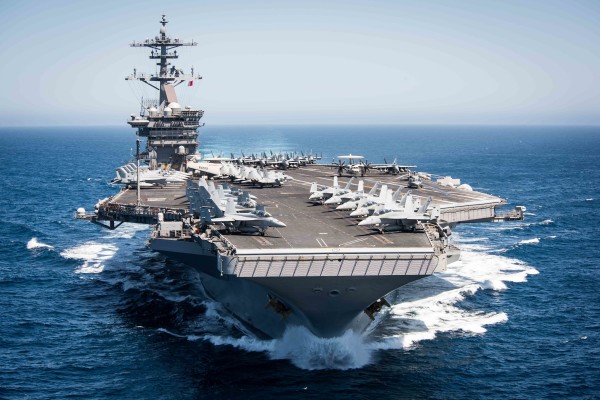

With the novel coronavirus (COVID-19) sweeping through the aircraft carrier USS Theodore Roosevelt, the only effective way to stop the disease would be to move most of the ship’s crew of roughly 4,000 sailors ashore and quarantine them for two weeks, the ship’s captain wrote in a letter to the Navy Department.
San Francisco Chronicle reporters Matthias Gafni and Joe Garofoli first revealed on Tuesday that the carrier’s commanding officer had asked the Navy Department for permission to move most of the Theodore Roosevelt’s crew off the ship.
At least 100 sailors on the carrier have reportedly tested positive for the coronavirus. The ship is currently at port in Guam.
“We are not at war. Sailors do not need to die. If we do not act now, we are failing to properly take care of our most trusted asset — our Sailors,” Navy Capt. Brett E. Crozier wrote in the letter.
If a war breaks out, the Roosevelt will respond and fight both the enemy and COVID-19, Crozier wrote. But since the United States is not at war right now, the Navy “cannot allow a single sailor to perish as a result of this pandemic unnecessarily.”
“Removing the majority of personnel from a deployed U.S. nuclear aircraft carrier and isolating them for two weeks may seem like an extraordinary measure. This is a necessary risk.”
“It will enable the carrier and air wing to get back underway as quickly as possible while ensuring the health and safety of our sailors,” he added. “Keeping over 4,000 young men and women aboard the TR is an unnecessary risk and breaks faith with those sailors entrusted to our care.“

A Navy official issued a statement on Tuesday that did not indicate if Crozier’s request would be granted.
“The commanding officer of the Theodore Roosevelt alerted leadership in the Pacific Fleet on Sunday evening of continuing challenges in isolating the virus,” the official said. “The ship’s commanding officer advocated for housing more members of the crew in facilities that allow for better isolation.”
“Navy leadership is moving quickly to take all necessary measures to ensure the health and safety of the crew of USS Theodore Roosevelt, and is pursuing options to address the concerns raised by the commanding officer.”
Crozier wrote that it is simply impossible to practice social distancing on warships, where the majority of the crew live in open bed and shared berthing and work in confined spaces.
Due to the close quarters aboard the Roosevelt, every sailor must be considered in “close contact,” he wrote.
Testing can only confirm whether sailors have the virus, not slow the spread of the disease, he wrote. Moreover, testing cannot prove that sailors does not have the coronavirus. Of the first 33 sailors diagnosed with the disease, 7 initially tested negative but then shows symptoms of the virus within three days.
“With the crew embarked, TR is unable to comply with CDC protocols or NAVADMIN 083/20 guidance,” Crozier wrote. “Based on CDC guidelines and TR observations, the only effective method to preserve an individual’s health is total isolation for 14+ days in accordance with the NAVADMIN (i.e. Individual hotel/barracks rooms with separate beds.) Due to a warship’s inherent limitations of space, we are not doing this. The spread of the disease is ongoing and accelerating.”
So far, the majority of Roosevelt sailors who have been moved ashore have been placed in group quarantine, which is “marginally better than a warship” but still falls short of the individual quarantine called for by the Navy and Centers for Disease Control and Prevention, Crozier wrote.
Two sailors moved to an open bay gymnasium with cots have already tested positive for COVID-19.
Crozier stressed that the current approach to containing the disease is not working. He cited a recent example of the cruise ship Diamond Princess, where isolating passengers in their cabins prevented an estimated 2,307 people from getting sick.
Evacuating all of the passengers early on would have been even more effective, which is why Crozier is asking for permission to move most of the Roosevelt’s sailors into individual quarantine while keeping about 10 % of the crew to man the nuclear reactor, clean the ship, and respond to any emergencies that arise.
“Every sailor onboard must be guaranteed virus-free and the ship environment must be disinfected,” Crozier wrote. “One infected sailor introduced to the ship will spread the virus.”
The Navy is looking how to get sailors off the Theodore Roosevelt, but right now there is not enough bed space in Guam to isolate each crew member individually, Acting Navy Secretary Thomas Modly told CNN later on Tuesday.
“So we’re having to talk to the government there to see if we can get some hotel space, create some tent-type facilities there, but we don’t disagree with the CO on that ship,” Modly said.
RIght now, the Navy is looking at how it can leave enough sailors aboard the Theodore Roosevelt to perform the essential tasks and clean the ship for when the rest of the crew comes back aboard, he said.
“We’re doing it in a very methodical way because it’s not the same as a cruise ship,” Modly said. “That ship has armaments on it. It has aircraft on it. We have to be able to fight fires if there are fires aboard the ship. We have to run a nuclear power plant.”
UPDATE: This story was updated on March 31 with comments from Acting Navy Secretary Thomas Modly.
SEE ALSO: COVID-19 situation report: The latest coronavirus updates from the US military